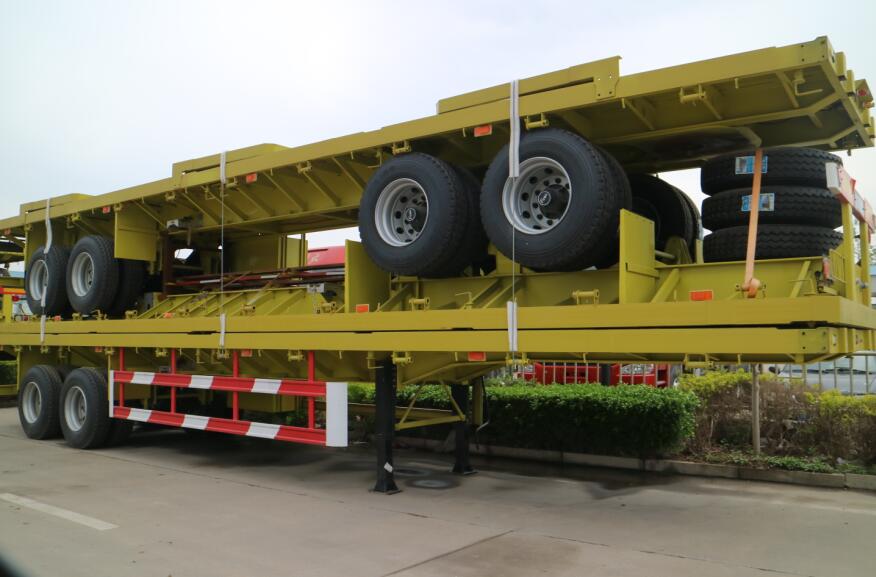This is a type of trailer used to transport common cargo or container. If you are transporting a container, you will need a container lock on the trailer.
Typically, it is a lightweight construction made of high-strength structural members that can be used together with a truck tractor.
What is a Container Trailer? – Learn Different Designs and Specs
Get Detailed Specifications!
1. Why the Semi Flatbed Trailer?
The semi-flatbed trailer is useful in its own way in that it is designed to provide a special, lightweight semi-trailer vehicle that enhances the load capacities.
With the enhanced suspension, the cargo on transit is secured safely to prevent any damage. Generally this type of trailer can easily and quickly be maneuvered and loaded based on standard loading procedures.
Semi flatbed trailer usefulness is made possible through the pair of longitudinal support beam sections, usually spaced apart in a parallel arrangement.
These extend forward from the back section of the trailer towards a wall position to the front in a perpendicular sense to the support beams.

The transverse cross-beams in this design function both as members offering structural support and as the lowest tier dunnage as well. This eliminates the need to have extra flooring sections that are usually the case in common semi-trailer designs.
A smoother ride is achievable with the semi flatbed trailer because of its enhanced suspension.
The semi flatbed trailer is a kind of vehicle with lighter dead weight, so, it allows the loading and transportation of heavy freight loads hence saving costs on fuel.
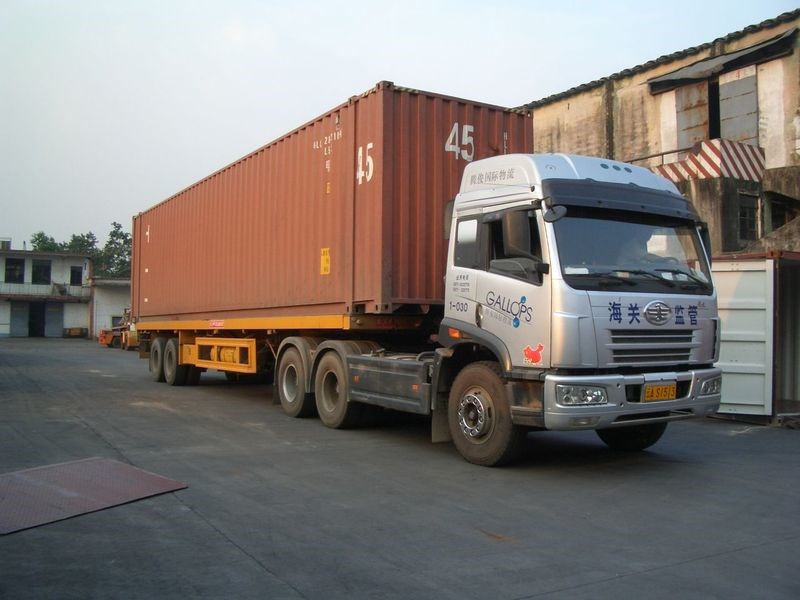
Loaded Semi-Flatbed Trailer
Get Detailed Specifications!
2. Drop Side / Side Wall Trailer
Drop side is similar as flatbed trailer, but it has the side wall. It is commonly used to transport bulk cargo.
This type of trailer is composed of a floor and a side wall that extends vertically upward as shown in figure 2 above. These side walls extend from the side edge of the trailer’s floor.
The side wall is a construction of several vertical posts where each post defines an inner surface disposed in a common plane as well as a recessed portion.

Side Wall Trailer
- Theory behind this Construction
Many trailers are known for transporting cargo. For instance, van type trailers basically are made of a deck assembly anchored by a side wall structure and have wheels and front legs.
The deck assembly construction is normally made of longitudinal floor members and a number of transverse cross-members, preferably I-beams that extend in between the opposing bottom rails.
The deck normally transfers the load to the rails at the bottom and the wheels.
However, based on whether the trailer is in a coupled position or is free-standing, the load is also transferred to a tractor fifth wheel or to the retractable front legs installed on the trailer.
Designs such as those of a monocoque trailer type are made of an individual inner side wall panel sections and an outer cover that are bonded together, usually through a post, z-shaped or channel structural member and again to a sub-frame to make a self-supporting construction.
Both the inner panel steel members and the outer cover could carry some of the stresses induced in between the floor, the posts and the roof of the trailer.
A common construction has the inner panels and the outer cover attached to several vertical posts usually spaced apart along the side wall of the trailer.
Typically, there would be a longitudinal central section together with a pair of longitudinal flanges that are disposed on both sides of the central section and recessed from it between the outer cover and the central section.
The outer cover/skin is then fastened to a pair of other longitudinal flanges through any means considered suitable for the application such as rivets.
Also, there are panels attached as side wall liners and are firmly fixed to the posts connected to longitudinal flanges.
A scuff band is also included on the trailer’s inner surface wall to prevent it from damage when the cargo is onboard during loading and offloading operations.
Should it be provided, the protective scuff band normally protrudes into a useable storage section inside the trailer.
Get Detailed Specifications!
3. Main Parts of Flatbed Trailer
To function as desired, the semi flatbed trailer is carefully design with different parts that work together to enhance operations.
These are both structural and electrical but all work in tandem to enhance the trailer function. Here are some of the main parts you will find in this type of vehicle construction.
3.1 Main beam
The most common main beam type for this trailer is the I-beam. Usually, I-beams have an upper plate, a vertical one and a lower plate. In most cases, the vertical plate will require punching.
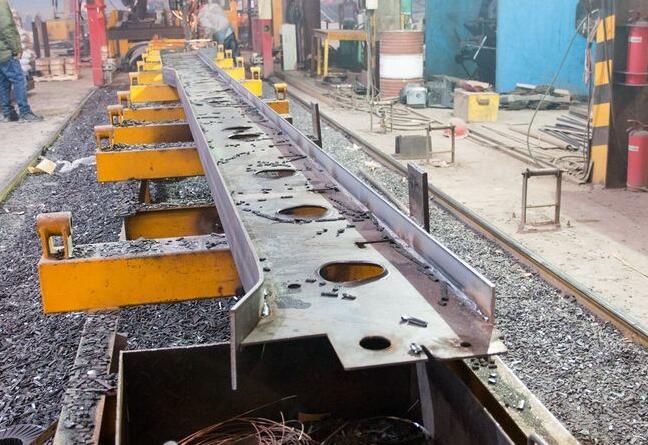
Main beam
This process is useful in reducing the trailer’s weight while at the same time enhance the strength characteristics of the main beam.
In most semi flatbed trailers, they are made of two main beams. However for a heavy construction, 3 beams can be used to enhance the cargo safety.
A semi flatbed trailer made of 3 beams is usually safer though heavier to use. Again, it is also costlier than other types of trailers.
Therefore, you should know what you need based on the cargo type you want to handle. This should help you determine the right number of beams needed in your application.
Characteristically, the main beams should be of high yield strength to offer support to the trailer. In that case, the ideal materials for use in this construction are the Q345, Q550, and Q690 steel sections.
For the rest of the other trailer members and beams, Q235 steel sections can be used. Side beams and cross beams are normally welded on the main beams.
3.2 Flatbed
The flatbed is the part that offers direct contact with the goods in everyday loading. They are by function and operation the most vulnerable parts of the trailer.
According to the type of goods carried they could be 3mm flat, 4mm flat, 3mm and 4.5mm plate pattern just to mention but a few. There could be other types of plates as well.
3.3 Suspension
There are three types of suspension systems: Mechanical suspensions, air suspensions and single point suspension. Each one of these comes with specific use and performances.
Ideally, you can choose from these suspension types based on the following factors as described below:
- Mechanical Suspensions
In some cases, you will find the term multi-leaf suspensions making reference to the mechanical suspensions. These types of suspensions are made of a series of reaction arms that are used to keep the axles in a horizontal position all the time.
The axles are usually kept in the right position even during extreme movements. For that matter the suspensions have a high stability and are useful in preventing tumbling during the transportation of heavy cargo.
The load distribution commonly in a semi flatbed trailer installed with mechanical suspensions is usually kept constant even with the application of brakes.
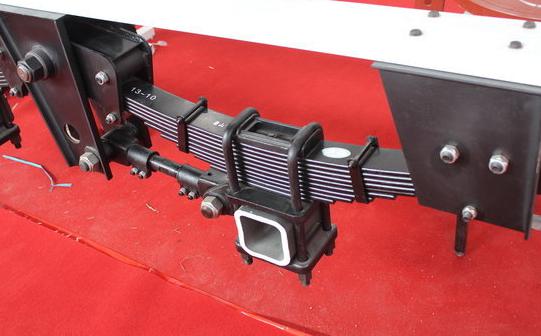
Spring mechanical suspension
These types of suspensions are most applicable for heavy-duty trailers. They are affordable and reliable at the same time. More than that, they are easy to maintain and come with a high load carrying capacity.
When on rough terrains, you don’t have to worry if you have multi-leaf suspensions. These are the type of suspension systems that you should go for if your budget is not big for your trailer purchase and maintenance.
You won’t incur much maintenance for mechanical suspensions as is the case with other suspension types. Most of them need minimal or no lubrication at all.
Common mechanical suspension models are loaded with a spring mechanism. This mechanism is used to reduce vibrations that get sent to various trailer components while in motion.
The effect of preventing vibration enhances the life of the components through a reduced rate of tear and wear.
- Air Suspensions
This is yet another suspension type that you could use. The main advantage of using air suspensions is for the reason that they are lighter than other types. Additionally, they provide good stability.
They are most preferred by drivers when transporting heavy cargo due to their flexibility. The spring stiffness adjusts to the cargo weight on the semi flatbed trailer.
For that reason, drivers can enjoy a better and comfortable ride with the use of air suspensions. Air suspensions are commonly associated with a longer tire life and good fuel economy.
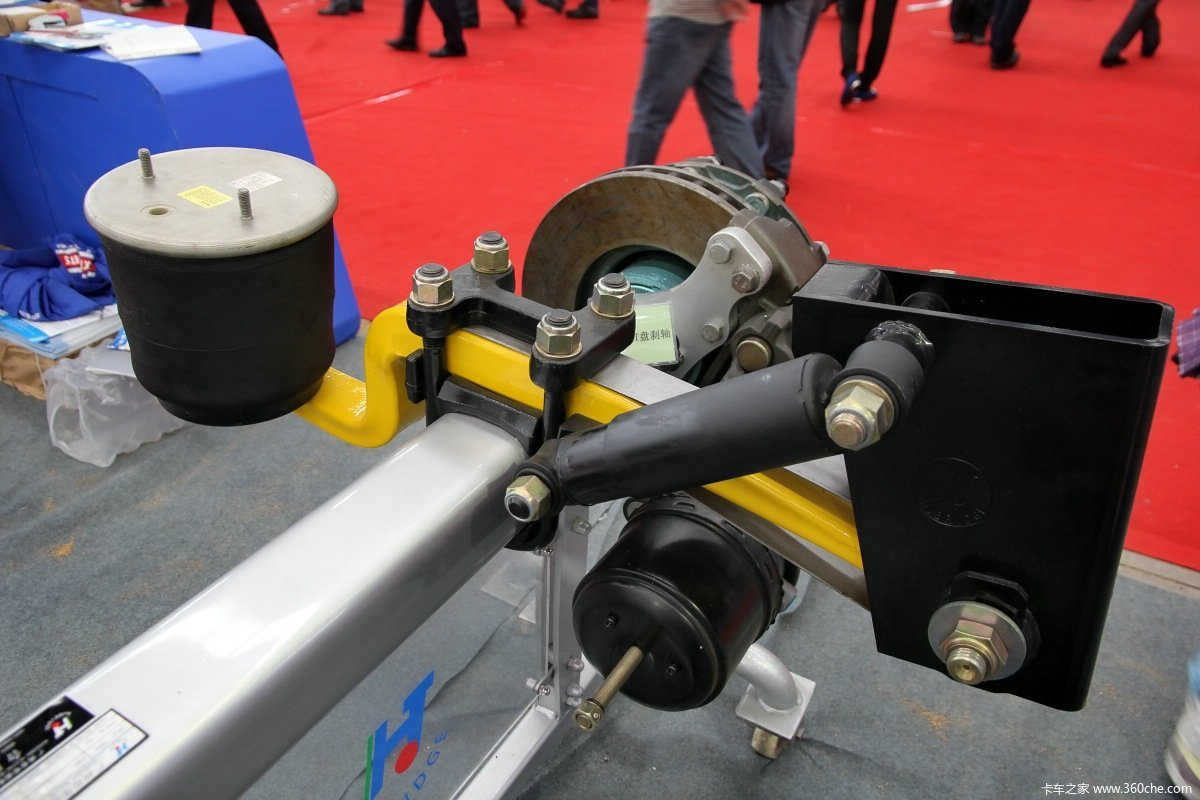
Air suspensions
These suspensions cut down the vibrations to various components and this amounts to less tear and wear in each of them.
With some of the air suspension models, the trailer axles that are not in use get lifted. Typically, the suspensions make it possible for the driver to make adjustments to the height based on the weight of cargo and the road surface terrain.
However, these suspension types are costly. This makes trailers with air suspensions more expensive than types of trailers.
- Single Point Suspension
This type of suspension is also known as heavy-duty walking beam suspension. These single point suspension types are used in handling high load capacity weighing up to 100 tons.
If your business deals with heavy cargo, these are the type of suspensions to go for. They are commonly found in trailers meant to take heavy cargo.
Additionally, these single point suspensions provide a god damping effect. They also reduce vibrations to the trailer components hence helping to enhance the life of the components through reduced tear ad wear.
The comfort of the driver is also enhanced greatly on rough road terrains or bumpy areas. Just like the air suspensions, the single point suspension is expensive.

heavy-duty walking beam suspension
The suspension types used in semi flatbed trailers depend on the cargo capacity in each one of them.
For example, ordinary semi flatbed trailer will use the mechanical suspensions whereas heavy-duty semi flatbed trailers need suspensions that have a high load carrying capacity such as the air suspensions or the single point suspension option.
Get Detailed Specifications!
3.4 Axles
Axles have different load capacities including 9T, 12T, 13T, and 16T among others. You can choose the most suitable axles for your semi flatbed trailer based on their capacity.
You will be provided with details and a complete guide on how to calculate the load capacity of axles to help you choose the right axles.
Another important aspect of axles that you should note is that, they have a self-steering model that uses either a hydraulic or an air system. The self-steering system is commonly used in multi-axles trailers to prevent tire wear.
The rear tires in multi-axles trailer wear out fast. Most of the tires in trailers do not have the steering function.
3.5 Gas and Electrical Circuitry
Gas circuit: This is normally used for normal driving brakes hence is connected to the emergency braking device. It is composed of a gas connector, inflatable pipeline, control lines, emergency relay valve, gas storage, brake chamber.
Electrical Circuit: This plays a role in lighting and signal transmission. It is usually connected with tractor truck through a seven-star plug. The line is generally hidden in the frame leaving it perfectly set without hanging cables.
4. How to Ensure the Welding Quality of Flatbed Trailer?
It is very important to know the manufacturing process of a semi flatbed trailer. This will help you when inspecting the final product and making a decision prior to purchasing it.
This knowledge will help you assess the quality of your trailer and whether it meets the set standards in the industry. This will help you stay safe from individual workshops that use sub-standard production methods.
Here is what to look for in a semi flatbed trailer.
- Cutting
A CNC cutting machine is used to cut out the steel plates including the web plate, reinforcing plate, and accessories. In other words, the machine is used to cut all steel plates required to make a complete semi flatbed trailer.
Punching holes on the steel sections is important because it reduces the weight and stress of the trailer. In addition, punching increases the strength of the beams leading to a robust construction.
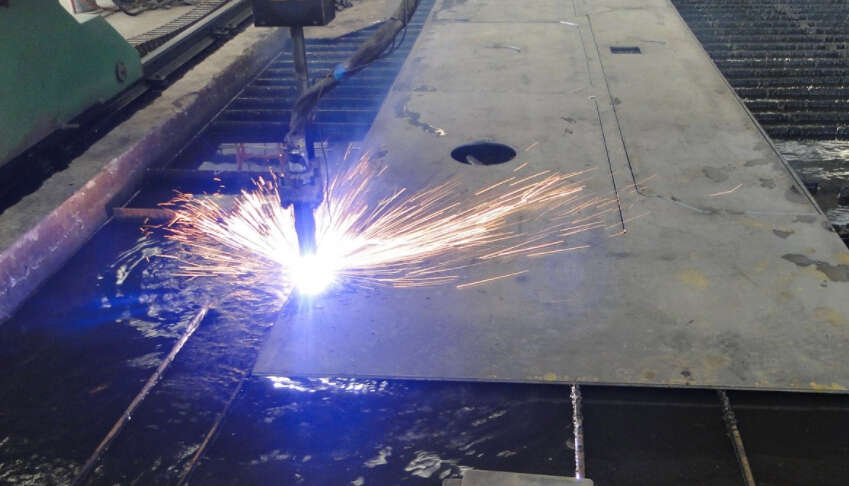
CNC cutting
- Bending
The next step after cutting the steel plate is bending according the drawing. Every manufacturing process starts with a drawing of the final product. Hence, the manufacturers must use the dimensions and shape on the drawing when bending the steel.
A fixture is used to fix the components to ensure that they are vertical and straight. This stage involves correcting and measuring to ensure that the plate is in the right dimension, straight, and vertical.
- Welding
Several components of a trailer require welding including the main beam, cross beam, spring brackets, and the floor. Welding is a very important step in the manufacturing process.
It must be done in the right way to ensure that the final structure is strong enough to handle heavy loads. Welding starts with the “I” beam, which is the main beam and proceeds to the cross beams.
The manufacturer must ensure that the 2 main beams are parallel to each other when welding. The two joints on the sides of the steel plate should be fully welded to ensure that the plates and beams are strong enough.
The main beam is usually welded by submerged arc welding machine. Other parts such as the cross beams, plate, and accessories among several others are welded by a welder.

Welding
After connecting all the beams and plates through welding, the manufacturer must check the strength of the key positions.
Sometimes, the process of joining heavy beams causes some joints to loosen. Hence, repair welding and reinforcement is necessary before the trailer leaves the workshop.
Get Detailed Specifications!
Conclusion
A Semi flatbed trailer is a lightweight trailer construction of high-strength structural steel. It gives you the option of using it with a truck tractor.
Typical semi flatbed trailers are made of 2 longitudinally spaced support beams but for heavy cargo carriers, the beams could be 3.
Detailed here are semi flatbed trailer specifications and characteristics that make a robust construction to facilitate loading, transportation and offloading operations.
Modifications can be made to the basic semi flatbed trailer to have a side wall trailer also known as a drop side trailer.
The present semi flatbed trailer invention addresses and recognizes the continuing considerations of making an improved trailer for carrying cargo.
This has been achieved by having in lace a trailer that has a floor and a side wall that extends vertically upwards from each of the floor side edges.
The side wall is also made of several elongated vertical posts where each posts is used to define the longitudinal inner surface with part of it disposed in a common plane generally and the other one recessed from the plane.
A scuff band is received inside the recessed areas so that the inner facing surface is typically co-planar with interior surface of the inside wall.
To make the right choice of a semi flatbed trailer, you should be knowledgeable about how it operates, its main parts and components and most specifically its manufacturing process.
With this information, you will definitely stand a good chance of making the right choice of semi flatbed trailer for your application.

